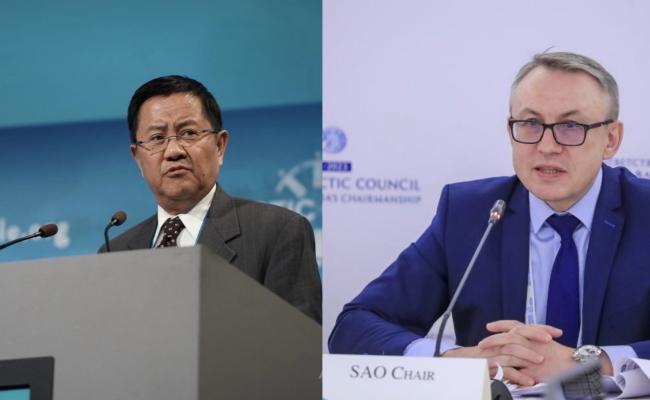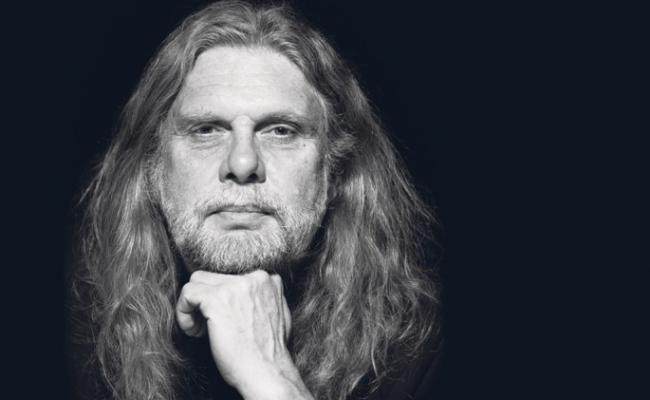Arctic Circle Assembly 2023: Arctic Council After Russia’s Handover: “We Are Still Here”
The Arctic Circle Assambly is like a Arctic family reunion. Iceland's Minister of the Environment, Energy and Climate, Gudlaugur Thór Thórdarson and Arcitc Senior Officials in the Arctic Council, Morten Høglund, are happy to see each other during the 10th edition of the conference. (Photo: Trine Jonassen)
Reykjavik (High North News): “I am here to tell you that the Arctic Council is not dead,” said the Arctic Council Chair Morten Høglund to a cheering congregation at the Arctic Circle Assembly in Reykjavik – revealing that the takeover from Russia was not certain until the day before.
It is no secret that Russia’s invasion of Ukraine a year and eight months ago caused tension in the Arctic Council – the High North's primary intergovernmental body.
Especially as Russia held the chairship of the council and had been shut out of all Arctic political conversations after the attack. The transfer of the rotating position from Russia to Norway in August seemed impossible.
But exactly how unnerving the situation was, few knew. The drama was well hidden behind the reassuring faces of the then Norwegian Foreign Minister Anniken Huitfeldt and Norway's Arctic Ambassador Morten Høglund.
When asked by the media, the answer was often "We do not know."
Celebrated
In the 26-year-long history of the Arctic Council, no member state had gone to war. And the work within the Arctic Council stopped for the first time. There was soon talk about the Arctic 7 and that the Council had lost its impact and purpose without Russia.
A fractioned Arctic Council could not do what it was meant to do.
Lars Løkke Rasmussen, Minister for Foreign Affairs in Denmark, said in his speech at the Arctic Circle Assembly stage on Thursday that the war in Ukraine had a significant impact on the cooperation in the Council.
Back to work
However, Norway successfully and carefully lifted the chairship out of Russia's hands, and the Norwegian leadership also got the council back to work. Slowly but steadily.
Had there been a prize for Arctic diplomacy, you would have won it
The task was celebrated amongst the international leaders and politicians who spoke at the Arctic Circle Assembly opening session in Reykjavik, Iceland.
"Had there been a prize for Arctic diplomacy, you would have won it," said Ólafur Ragnar Grímsson, Chairman of the Arctic Circle, to Morten Høglund, who sported a big smile throughout the conversation.
Very much alive
Reflecting on last year, the mood was dimmer. A year ago, few believed that the Arctic Council could be saved.
"A year ago, I attended this conference during the Russian chairship. All work within the Arctic Council was paused, and some considered it dead," said the Chair of the Arctic Senior Officials.
During the historic 13th Council meeting last August, where the baton was successfully handed over to Norway, the Arctic Council stated the unique position it holds, not only in the High North but also globally.
Uncertainty
Yet, behind closed curtains, Høglund now reveals that the situation with the takeover remained uncertain until the final hour.
"It was only the day before I felt like it would happen."
"But today, I stand here to tell you that the Council is very much alive and that all working groups are committed."
SAOC Morten Høglund were celebrated at the Arctic Circle Assembly in Reykjavik for his effort to keep the Arctic Council alive. (Photo: Trine Jonassen)
The working groups' work has gradually resumed, though not at the normal speed or level.
"It is not business as usual," says Høglund.
Transparent with Russia
So how did they do it with no political contact? By colleagues that made sure that the Council was safeguarded.
Shortly after Norway took over, a consensus decision allowed the member states to communicate in writing without having to meet. This was considered an important step forward and will be reviewed at the end of the year.
“It was also important to be transparent with Russia. We really wanted to succeed. It was just hard work over a period of a long time.”
And it paid off.
Also read
The most important Chairship
"The current situation shows that all the hard work and cooperation from all parties demonstrates the seriousness and commitment by the Norwegian chairship – the most important chairship in the council's history," states Høglund.
At the beginning of October, the Norwegian Chairship had its first meeting with the six indigenous permanent participant organizations.
The meeting facilitated discussions on plans during the Norwegian Chairship until Denmark takes the lead in 2025, the status of the council, and the resumption of work at the Working Group level.
The meeting also allowed the Permanent Participants to raise their priorities in the Arctic Council's work as the Norwegian Chairship moves towards the future.
Not without the Indigenous People
Høglund says it is important to look ahead rather than to the past. And ahead are melting ice caps, wildfires, the loss of youth, and the dire needs of the Arctic indigenous population. In Russia, as well.
Youth and indigenous people are at forefront of climate change
"We cannot turn our heads away from the climate change before us. We live in a time of multiple crises. It is imperative that new energy sources must not be developed at the expense of the indigenous population of the Arctic," says Høglund.
"Youth and indigenous people are at the forefront of climate change. No acts will be carried out within the Arctic Council without involving them."
Wildfire initiative
He mentions some of the council's work that led to legally binding agreements on scientific cooperation, search and rescue operations, and marine pollution.
Before Russia invaded Ukraine, one of the working groups was looking into a project to fight and prevent wildfires raging across the Arctic at rates never seen before. The project was led by the U.S. and Russia.
Now, at the conference, the Arctic Council will restart the work. On Thursday, the Norwegian chairship relaunched the project as a new wildland fire initiative.
It is designed to get communities and countries to share best practices for preventing Arctic fires.
Successful meetings
Going forward, Høglund will do his best to keep the Arctic Council working even if there are still no political meetings.
"It is a gradual approach. There are 8 Arctic states, so given the geopolitical situation, it is difficult. But we are a circumpolar body, which is reflected in the council," says Morten Høglund.
Now, it is about figuring out how to work in this geopolitical climate.
"Because the Arctic is our home."




